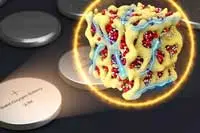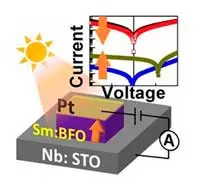Electronics News
Archive : 27 July 2016 год
 While lithium-air batteries are seen to be promising for use in electric cars and portable electronic devices, they waste energy and degrade relatively quickly. A further constraint is their open cell configuration, which requires extra components to pump oxygen in and out. Despite these drawbacks, they hold the prospect of delivering high energy output per weight.
While lithium-air batteries are seen to be promising for use in electric cars and portable electronic devices, they waste energy and degrade relatively quickly. A further constraint is their open cell configuration, which requires extra components to pump oxygen in and out. Despite these drawbacks, they hold the prospect of delivering high energy output per weight.
However, a variation of the battery chemistry, developed by a team at MIT, could be used in a conventional sealed battery. The new approach relies on the creation of nanoscale particles – nanolithia – containing lithium and oxygen, confined tightly within a matrix of cobalt oxide, which stabilises the particles and acts as a catalyst.
Professor Ju Li says there is a mismatch between the charging and discharging voltages, with the output voltage more than 1.2V less than charging voltage. “You waste 30% of the electrical energy as heat in charging. It can actually burn if you charge it too quickly,” he says.
Conventional lithium-air batteries draw in oxygen from the air to drive a chemical reaction with lithium during the discharging cycle. Oxygen is then released to the atmosphere during the reverse reaction.
In the new variant, called a nanolithia cathode battery, the same kind of electrochemical reactions take place, but without the oxygen reverting to a gaseous form. Instead, says the team, the oxygen transforms directly between its three redox states, while bound in the form of three different solid chemical compounds – Li2O, Li2O2, and LiO2 – which are mixed together in the form of a glass. This reduces the voltage loss to 0.24V, so only 8% of the electrical energy is turned to heat. “This means faster charging for cars, as heat removal from the battery pack is less of a safety concern, as well as energy efficiency benefits,” Prof Li adds.
Because the ‘solid oxygen’ cathodes are lighter than conventional lithium-ion battery cathodes, the new design could store up to twice the amount of energy for a given cathode weight, the team says. With further refinement of the design, says Prof Li, the new batteries could double that capacity again.
The team expects to move from a lab scale proof of concept to a practical prototype within a year.
Pic courtesy MIT research team
Author
Graham Pitcher
Source: www.newelectronics.co.uk
 Altitude Partners, the regional private equity fund, has completed a development capital investment into Moortec, a semiconductor Intellectual Property (IP) business supplying ‘in-chip’ monitoring circuits. Moortec’s IP technology serves tier one consumer, enterprise and automotive technology companies.
Altitude Partners, the regional private equity fund, has completed a development capital investment into Moortec, a semiconductor Intellectual Property (IP) business supplying ‘in-chip’ monitoring circuits. Moortec’s IP technology serves tier one consumer, enterprise and automotive technology companies.
Jonathan Simm, partner at Altitude comments: “There is extraordinary innovation in the UK. Stephen and the team at Moortec are a superb example of this, creating and developing a business which is at the cutting edge of semiconductor design.”
Moortec has developed a core portfolio of IP for ‘in-chip’ sensors. The three prime areas of Moortec’s expertise are process monitoring, voltage supply monitoring and temperature sensing (‘PVT’ monitoring). Moortec’s monitoring IP is said to be present in more than 10 million smartphones.
Altitude’s investment will assist the business in developing and strengthening both its engineering and sales team and adding new silicon proven designs to their IP portfolio at smaller technology nodes.
Stephen Crosher, Moortec’s managing director said: “Moortec is an ambitious company with plans to develop a number of new IP product lines in to a rapidly expanding market for in-chip monitoring solutions. Support from the team at Altitude and in particular its experience of business growth will prove invaluable.”
Author
Peggy Lee
Source: www.newelectronics.co.uk
 Work undertaken at the King Abdullah University of Science and Technology could lead to smaller memory chips that consume less power and which can be controlled and probed by light.
Work undertaken at the King Abdullah University of Science and Technology could lead to smaller memory chips that consume less power and which can be controlled and probed by light.
The technology is based on a ferroelectric tunnel junction (FTJ) – in which a thin layer of a ferroelectric material is sandwiched between two electrodes. In this case, a layer of samarium doped bismuth iron oxide (SBFO) – ranging in thickness from 3 to 9nm – was placed between platinum and niobium doped strontium titanate, which is light sensitive.
In one of its polarisation states, SBFO has a low tunnelling electroresistance (TER) that allows electrons to pass. However, in its other polarisation state, the TER is 100,000 times larger, which prevents tunnelling. According to the researchers, this is the largest change in TER ever seen for a FTJ and provides an ‘unambiguous’ way to read polarisation state. However, when exposed to ultraviolet light, TER was reduced by a factor of 10.
“This means that we could acquire four electronic states, corresponding to polarisation direction (left or right) and illumination condition (dark or light),” noted researcher Tom Wu. “Each electronic state can be used to store one bit of information. By introducing light into FTJs, we double the data storage density, which could be very promising for future technology.”
Switching from one state to another took 10µs, said to be faster than conventional flash, but slower than some other forms of memory. Meanwhile, while the difference in TER between the two states is said to decrease gradually, the team believes the approach will still be suitable for long term data storage.
“One immediate goal of our research is to make these FTJ devices smaller and faster,” said Wu. “In addition, we will work to enhance the light detection capability of such ultrathin junctions.”
Author
Graham Pitcher
Source: www.newelectronics.co.uk

